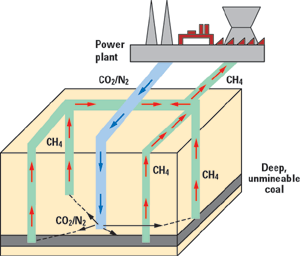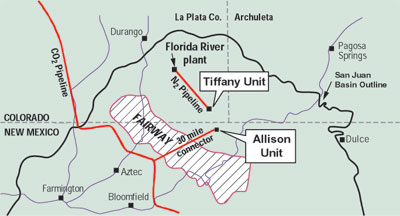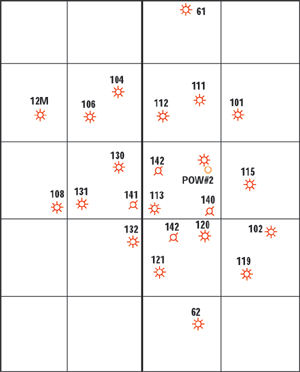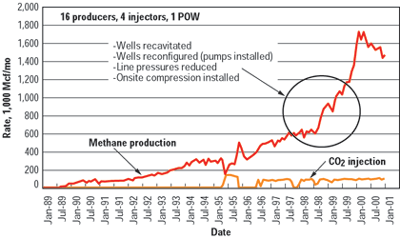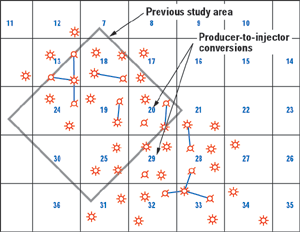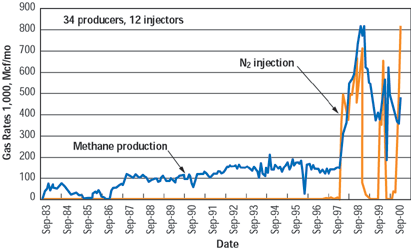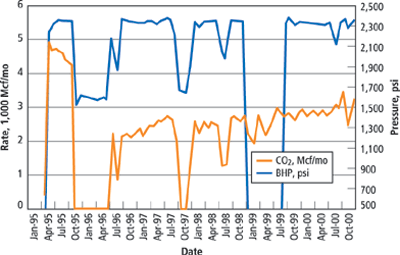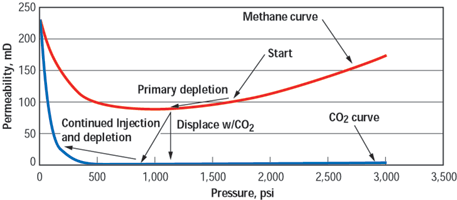Field studies of enhanced methane recovery and CO2
Natural Gas TechnologyField studies of enhanced methane recovery and CO2 sequestration in coal seamsInterim report on three-year DOE-sponsored research project in two San Juan basin coalbed methane fields reveals important reservoir data on CO2 injection for both reducing atmospheric carbon and improving methane recoveryScott Reeves, Advanced Resources International, Houston In October 2000, a three-year government-industry project known as the Coal-Seq project was launched in the U.S. The project, funded by the U.S. Department of Energy (DOE), and being performed by Advanced Resources International (ARI), together with industry partners Burlington Resources and BP America, is studying the feasibility of CO2 sequestration in deep, unmineable coal seams using enhanced coalbed methane (ECBM) recovery technology. The project is specifically focused on understanding results of actual field experiments via reservoir modeling. The project is also conducting supporting studies into effects and modeling of multi-component sorption and coal swelling. The fields being studied are both in the San Juan basin of NW New Mexico and SW Colorado. The sites are the Allison Unit, operated by Burlington Resources and the Tiffany Unit, operated by BP America. These two sites are the only two in existence, worldwide, where long-term, multi-well injection of CO2 or N2 is being performed. The interest in understanding the N2-ECBM process has important implications for CO2 sequestration via flue-gas injection. This article describes results and findings from the project through mid-2002. SEQUESTRATION BACKGROUND As reported in the author’s paper SPE 717491, the concentration of CO2 in the atmosphere is rising and, due to growing concern about its effects, the U.S. and more than 160 other countries ratified the Rio Mandate in 1992, which calls for “... stabilization of greenhouse gas concentrations in the atmosphere at a level that would prevent dangerous anthropogenic interference with the climate system.” Since under virtually any stabilization or market scenario, fossil fuels will remain the mainstay of energy production for the foreseeable future, even modest stabilization will require enormous reductions in greenhouse gas (GHG) emissions resulting from fossil fuel use. Energy-related CO2 emissions resulting from fossil-fuel combustion account for 82% of all U.S. GHG emissions. 2 Achieving atmospheric stabilization that is deemed acceptable will require large-scale, low-cost sequestration of carbon, a need for which no cost-effective technology exists today. As a result, the U.S. DOE developed its carbon sequestration R&D program, which addresses the entire carbon “life cycle” of capture, separation, transport and storage or reuse. Of high priority are geologic options for “value-added” sequestration with multiple benefits, such as using CO2 in enhanced oil recovery (EOR) operations and in methane production from deep, unmineable coal seams, which provide the greatest opportunity for near-term, low net-cost CO2 sequestration. The concept and synergies of CO2 sequestration and ECBM recovery are shown in Fig. 1. Here, a flue gas (presumably with some pre-treatment for contaminant and/or dilutent removal) from a power plant is injected into nearby coal seams, where the CO2 is sequestered and methane production from the coal is enhanced. To understand these synergistic gas recovery and CO2 sequestration opportunities, in October 2000, DOE awarded a 3-year R&D contract to ARI, together with industry partners Burlington Resources and BP America, for the purpose of studying and understanding the reservoir mechanisms of CO2 sequestration and ECBM via a combination of lab studies and field demonstrations.
FIELD RESULTS The field R&D sites located in Colorado and New Mexico are shown in Fig. 2. At Allison, CO2 is being injected, and the CO2 is sourced from a nearby pipeline that transports it from the Cortez area of New Mexico to West Texas for flooding of oil reservoirs. For the Tiffany project, into which N2 is being injected, the N2 is sourced from an air separation plant located at BP’s Florida River gas processing facility.
Allison Unit. This study area consists of four CO2 injector wells and 16 methane producers, Fig. 3. The field originally began production in 1989, with CO2 injection beginning in 1995. The production / injection history for the field is illustrated in Fig. 4. Note that for a period following commencement of injection operations, other production enhancement activities were also performed, such as recavitations, well reconfigurations and installation of dewatering pumps, line pressure reductions and implementation of on-site compression.
To understand the field results, particularly with the operational complexity that exists, the field was simulated and matched with a three-layer reservoir model, using ARI’s COMET2 simulator. Using the calibrated model, an analysis of incremental methane recovery due to CO2 injection was performed. The results indicated that about 1.6 Bcf of incremental methane will be recovered as a result of injecting 6.3 Bcf of CO2. This yields a CO2/CH4 ratio of 3.2 (after accounting for reproduced CO2), consistent with the CO2/CH4 sorptive capacity ratio based on isotherms at the abandonment pressure of about 50 psi. Tiffany Unit. This area comprises 12 N2 injector wells (10 of which are directional) and 34 methane producers, Fig. 5. The field originally began production in 1983, with intermittent N2 injection beginning in 1997. The production / injection history for the field is illustrated in Fig. 6.
To analyze Tiffany’s results, this field is also being simulated and matched with a four-layer reservoir model, and also using ARI’s COMET2 simulator, a process which is presently underway.
RESERVOIR MECHANISM STUDIES In addition to the field modeling work, studies of coal sorption behavior and coal swelling are also being performed to understand their impact, as well as how to appropriately model them. Multicomponent isotherm behavior. In the mid-1990s, some researchers published results of isotherm measurements for CH4, N2 and CO2 on San Juan basin coal.3 The results indicated an abnormal increase in adsorption capacity for CO2 around its critical pressure. Several different theories on the cause for this abnormal behavior have been proposed, the most common of which is multi-layer adsorption. The important consequence of this behavior is that the Langmuir equation is not valid for describing this response, which is the most common method used in reservoir simulators. To further evaluate this phenomenon, a new set of isotherm measurements were performed on a coal sample from the Tiffany Unit. Sorption measurements were taken at pressures well above the CO2 critical pressure, such that the abnormal behavior, if it exists, could be replicated. Results of the study, performed by some of the same investigators that originally performed and reported the abnormal behavior, did not show, this time, the abnormal behavior. It was discovered that an error in reducing the measured data to absolute sorption units, magnified by the closeness of the density in the gas and adsorbed phases near the critical point, was the source of the “abnormal” behavior. The investigators had identified the problem prior to this effort, but absence of the behavior was clearly established as a finding of this work. Another just as important finding was that, while sorption models such as Langmuir can adequately describe sorption behavior, no known model – Langmuir or otherwise – can accurately predict multi-component sorption behavior based on single-component data. In general, the error is larger, the greater the difference in adsorptive capacities for the gases, and is larger for the less-adsorptive gas. Coal swelling behavior. It is well established that, as gas is released from a coal reservoir, the coal matrix shrinks, and cleats open, creating a significant improvement in coal (cleat) permeability. There has also been speculation, and some lab evidence, that the process also works in reverse; that is, as gas is adsorbed onto coal, the matrix swells, cleats close and permeability is reduced. Since CO2 is much more adsorptive on coal than methane, the problem is exacerbated with CO2 injection. To examine this effect, as well as how to model it, injection histories of the four CO2 injector wells at the Allison Unit were studied. Pressure transient test results for the wells were also available. Fig. 7 presents the CO2 injection rate and computed BHP for one of those wells. Initially, injectivity declined significantly. Subsequent to that, injectivity began a long period of improvement, which has continued through the last available data. These trends are consistent for all four of the injecton wells.
Pressure transient data from several producing wells in the field in the vicinity of the four injector wells had been collected in May 2000. The results of their analysis suggested that in-situ coal permeability for the area was in the 100 to 130-mD range. In August 2001, the four injector wells were temporarily shut-in, and BHP data was collected. Results of analyzing this data suggested coal permeabilities in the >1 mD range – two orders of magnitude less than implied initial values, and a reduction of 99%. This data provides our first insight into the potential magnitude of coal permeability reduction with CO2 injection on a field-level basis. Using the ARI’s permeability function model,4 the permeability history of the injector wells was rationalized, as illustrated in Fig. 8. First, coal permeability at the injection well locations declined with a reduction in pore pressure. When the injection wells were drilled and injection commenced, a rapid reduction in permeability occurred as the permeability trend shifted from the methane to the CO2 curve.
Later in injection well history, as the area under injection became further depleted and reservoir pressures declined, matrix shrinkage began to occur, leading to a continual and gradual improvement in injectivity. While somewhat subjective, this explanation is entirely consistent with field data, results of reservoir simulation studies, and predicted response based on the permeability function model. INTERIM CONCLUSIONS, FUTURE WORK To date, the project has demonstrated that both CO2 and N2 injection can materially improve gas recoveries from coal seams; and the processes can be reasonably modeled with today’s numerical simulators. However, some uncertainty remains on specific reservoir engineering issues, such as coal permeability reduction with CO2 injection, and multi-component sorption behavior. In addition, the ability of coal seams to sequester CO2 for long time periods (hundreds of years) remains unclear. Present work on the project is focused on completing the Allison and Tiffany field studies. Once complete, the efforts will shift to “extrapolating” what was learned to more widespread applicability in other U.S. coal basins. Specifically, a scoping assessment of ECBM recovery and CO2 sequestration potential for each U.S. coal basin will be performed, and a screening model constructed to evaluate site-specific project opportunities. The results of this work will be made publicly available. Acknowledgment The work described herein was funded by the U.S. Department of Energy, National Energy Technology Laboratory (Contract No. DE-FC26-00NT40924). The author acknowledges the important contributions of both Burlington Resources and BP America to this work, by making their field data available for analysis, and for their insights and field observations. Acknowledgment is also extended to Oklahoma State University for performing the isotherm work and its analysis presented here. Literature Cited 1 Reeves, S. R., “Geological sequestration of CO2 in deep, unmineable coalbeds: An integrated research and commercial-scale field demonstration project,” paper SPE 71749, presented at the 2001 SPE Annual Technical Conference and Exhibition, New Orleans, LA., September 30-Oct. 3, 2001. 2 “Emissions of greenhouse gases in the United States, 1999,” EIA/DOE-0573 (99). 3 Hall, F. E., C. Zhou, K. A. M. Gasem and R. L. Robinson, “Adsorption of pure methane, nitrogen and carbon dioxide and their binary mixtures on wet Fruitland coal,” paper SPE 29149, presented at the 1994 Regional Conference and Exhibition, Charleston, South Carolina, Nov. 8-10, 1994. 4 Sawyer, W. K., G. W. Paul and R. A. Schraufnagel, “Development and application of a 3D coalbed simulator,” CIM/SPE 90-119, presented at the International Technical Meeting, Calgary, Alberta, June 10-13, 1989.
|
|||||||||||||||||||||||||||||||
- What's new in production (February 2024)
- Prices and governmental policies combine to stymie Canadian upstream growth (February 2024)
- U.S. operators reduce activity as crude prices plunge (February 2024)
- U.S. producing gas wells increase despite low prices (February 2024)
- U.S. drilling: More of the same expected (February 2024)
- U.S. oil and natural gas production hits record highs (February 2024)
- Applying ultra-deep LWD resistivity technology successfully in a SAGD operation (May 2019)
- Adoption of wireless intelligent completions advances (May 2019)
- Majors double down as takeaway crunch eases (April 2019)
- What’s new in well logging and formation evaluation (April 2019)
- Qualification of a 20,000-psi subsea BOP: A collaborative approach (February 2019)
- ConocoPhillips’ Greg Leveille sees rapid trajectory of technical advancement continuing (February 2019)

